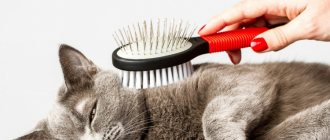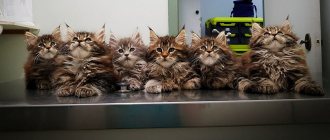The appearance of a kitten in the house is always a joyful event, but at the initial stage it may be accompanied by some problems. Not all little pets immediately get used to going to the toilet in a place strictly designated for this purpose.
Sometimes incorrect actions or mistakes on the part of the owners aggravate the existing problem, but if you follow a number of rules, you can quickly teach the kitten to go to the toilet in a special tray or use the toilet. This article will reveal all the secrets of this process.
Brief answers to frequently asked questions
| Age at which a kitten should be litter trained | The earlier the better. By 3-4 months of age, a kitten from a nursery must be toilet trained. Training adult cats is a more complex process that requires vigilant supervision. |
| How quickly will a kitten get used to going to the litter box on its own? | It will take 2-3 weeks for the kitten to start using the litter box on his own. |
| With or without filler | Depends on which option the kitten was accustomed to by its mother or breeder. At first, it is better to leave the conditions familiar to the baby. The filler is changed or removed 1-2 weeks after settling into the new home. |
| Will special sprays help to scare away from corners and attract to the tray? | These products should be used only if the kitten, after a week, very often or completely ignores the tray, as well as to correct the behavior of adult cats. Although the problem may be in the choice of the tray itself, the filler or the place where the toilet is located. |
| Why leave paper soaked in urine or pieces of feces in the tray? | Cats trust their sense of smell, so a place where there is already the smell of their excrement is established as a toilet. This is why it is so difficult to wean cats from their favorite odorous corners in the apartment. |
| Which filler should I choose? | The best choice would be clay, fine wood or corn fillers. Do not take litter with large fractions for your kitten; it will be painful for him to sit on the granules. It is better to postpone the option with silica gel too; the kitten can taste them out of curiosity, and its granules have a powerful absorbing effect. |
Acts of urination and defecation at different ages
The health of the animal depends on the number of times your pet goes to the toilet. In order not to miss pathologies or any diseases, the owner should know how often cats of different ages go to the toilet, and what to do if the kitten does not defecate for a long time.
It's easier to litter train a small kitten
Newborn kittens
In the first three weeks after the kittens are born, the mother cat helps the newborns with going to the toilet. By licking them, she not only cleanses her children of dirt and foreign odors, but also stimulates blood circulation in the digestive organs. This massage helps the baby get rid of gases and have a bowel movement.
Note! If the mother cat cannot care for the kitten, then taking care of it falls on the shoulders of the owners. Therefore, the owner should stimulate bowel movements by stroking every 2 hours before the pet begins to eat and after.
When the baby refuses to go to the toilet in a big way for several days, you can do some manipulations. They will help eliminate gas from a bloated tummy. To do this, take a soft brush or cotton wool soaked in warm water and gently begin to massage the kitten’s belly in a clockwise direction.
Month old kittens
When a small pet has reached the age of 3 weeks, its intestines are already formed, have beneficial microflora and are ready to accept more adult food. During this period, the kitten still feeds on mother's milk, but with the gradual introduction of complementary foods in the form of creamy or liquid food.
At the age of three weeks, the kitten has formed a reflex of urination and defecation, so the pet begins to go to the toilet on its own about 3-6 times every day. Normally, a kitten’s stool should have a mushy appearance, be thick and uniform, without any impurities (undigested pieces of food, mucus). The animal itself must be vigorous.
Important! An alarm bell is the presence of too dry or liquid feces in a kitten.
If your pet does not go to the toilet regularly for more than 3-4 days, it is worth reviewing its diet. Abdominal massage and microenemas will help you defecate.
Massaging the kitten's tummy in a circular motion to improve bowel movements
Despite the fact that small cats at the age of one month can defecate on their own, their mother helps them with this process for some time.
Adult kittens
A young cat switches to adult food at the age of one to three months. At this time, his feces are already more solid. The frequency of trips to the toilet, the consistency of excrement - all this depends on the animal’s diet.
Note! If he is fed a high fiber diet, the number of bowel movements will increase compared to if he was fed a high protein diet.
An already grown-up pet should go to the toilet a lot every day, and its waste products should not contain admixtures of mucus, blood or undigested pieces of food. The owner should be alerted when kittens begin to poop liquid feces.
This is interesting: Can a cat be given Aspirin?
Everything you need to toilet train your kitten
Before you begin training your kitten, you will need to make sure that you have everything necessary for this process:
It is recommended to make a choice in favor of odorless fillers, and you can experiment by purchasing a clumping and non-clumping variety
- Tray. There are many different varieties of cat litter available at pet stores, but for kittens in the learning phase, an open litter box with low sides . A tray with high walls or a door will be too difficult for a kitten to climb into, which can significantly slow down the process of habituation. Starting from 5-6 months of age, you can take a closer look at closed models of cat litter.
- Filler or lack thereof.
- If you bought a kitten, then ask the breeder which option the baby is accustomed to. Good nurseries sell babies who are already toilet trained, but in a new place you need to reinforce the habit.
- Outdoor foundlings are used to relieving themselves in sand and soil, so take a closer look at clay or wood pellets.
- If the tray is used without filler , then be prepared to clean the toilet immediately after the pet so that the smell does not spread throughout the room. It may be worth installing a couple of litter boxes to ensure your kitten always has access to a clean litter box.
- Selecting filler type . If you have several cats, it is better to take an absorbent litter, while a clumping one will make daily cleaning of the litter box easier.
- A set of sprays that have scents that are attractive and repulsive to cats. They may be required if the kitten ignores its litter box or systematically goes to the toilet in a chosen place that is not intended for such purposes.
- Scoop for cleaning the tray.
- Bedding , which is usually placed under the tray. It may be required so that the kitten, when getting out of its litter box, does not spread litter particles around the house on its paws. Pet stores usually sell special rubber mats that are very easy to clean.
- partition may be required if you need to create a temporary enclosed space for your kitten in close proximity to the litter box to get used to it.
- The food bowl and tray should be located sufficiently far from each other. At the same time, during training, it is recommended to limit the kitten’s movement around the apartment: it is advisable that he always stay in the same room until he understands what exactly is required of him.
Deviations from the norm in the toilet: causes of the disease
It happens that a kitten has an abnormal frequency of urination. They are divided into 2 cases: safe and incorrect.
The first include:
- acclimatization;
- menu changes;
- stress caused by adopting or adding a new pet to the family;
- operations: sterilization or castration.
The factors listed above are only temporary difficulties. After adaptation, everything returns to normal.
There are also more serious reasons. If urination brings pain to the animal or urine is released in limited quantities, this is an alarming sign.
Pathologies are cases when:
- there is mucous secretions or blood in the urine;
- limited discharge;
- heat;
- bloated tummy;
- plaintive meowing during bowel movements;
- inability to urinate;
- hot ears;
- dry nose;
- lethargy, reluctance to eat your favorite food.
You can tell that a pet is sick by its condition. The animal sits in an unnatural position:
- the animal's body is hunched;
- muscles are tense;
- the back is arched.
At the same time, the animal may cry pitifully. The kitten may also refuse to go to the toilet if the tray has not been washed for a long time or if it is dissatisfied with the litter.
Step-by-step instructions for toilet training a kitten
Important! It will take 2-3 weeks to develop sustainable behavior . Do not scold your baby if he makes mistakes in the first days.
After everything you need has been purchased and prepared, you can proceed directly to the process of training your small pet:
- The kitten must be placed in the litter tray on its own; it is advisable to do this while the kitten is inspecting the new home. Let him sit in it for a while, even if he doesn’t want to go to the toilet, this will allow him to get used to the new smell and tactile sensations when the selected filler comes into contact with his paws. It is also necessary to move him to this place 15-20 minutes after each meal, as well as in situations where he begins to sit in the corners.
- During training, you should not try to accustom your pet to burying , depicting the corresponding actions: this technique is not particularly effective, but it can greatly frighten him.
- After the kitten has done its job in the right place, it should be stroked and praised, expressing your approval. At the same time, you should not raise your voice and punish for any offenses while in the tray, as this may give him the wrong associations.
- Adult cats usually go to the toilet based not only on their habits, but also on the smell. Kittens are no exception, so if they make a mistake, you can blot the urine with a cotton napkin and put it inside the tray.
- A small amount of excrement can be kept inside the tray for the first few weeks , which will remind the small pet of what the toilet is intended for. However, with each successful visit, you must remember to replace them with fresh samples.
- If any difficulties are encountered during the training process, then you will need to install 1-2 additional trays so that the pet always has a choice. This can greatly facilitate the task.
After the kitten has done its job in the right place, it should be stroked and praised, expressing your approval
What to do to avoid urinary problems
Every kitten owner should understand that if a pet has problems with urination, it will be quite difficult to get rid of them. In order for the animal to remain healthy, feel comfortable and lead a full life, some measures should be taken to prevent bladder diseases and visit a veterinarian in a timely manner.
How often do kittens go to the toilet: how many times a day?
To prevent possible urinary problems, you should follow the following recommendations:
- the pet should not be allowed to become hypothermic;
- the animal needs to move a lot, for this you should play outdoor games with your pet that last at least 30 minutes. every day;
- the cat should be vaccinated in a timely manner in order to reduce the risk of developing various diseases;
- the animal’s diet should not include prohibited foods; it must be prepared in accordance with all rules for feeding cats;
- Water for a kitten should always be fresh and clean. At the same time, the pet must have unhindered and constant access to water.
Important! If your cat has some urinary problems, then only a veterinarian should treat it. Self-medication can harm the health and life of your pet.
Treatment of a kitten should be carried out only after visiting a veterinarian and on his recommendation
Thus, kittens go to the toilet on their own starting from three weeks, and as they grow older, the number of trips in a small way is from 5 to 10 times a day and in a large way up to about 3 times a day. If it is noticed that the pet defecates less than the specified amount or does it with difficulty, this behavior is a reason to check with a veterinarian. The most important thing in caring for a cat is to remember that you don’t need to scold your pet for mischief; here you should be patient with the baby.
Rules for toilet training a kitten
Below are the basic rules that you must follow to simplify and speed up the process of training your pet to the litter box:
- If the kitten went to the toilet in the wrong place, there is no need to raise your voice or use physical training methods. Most likely, he will not understand the reasons for the punishment, but will experience fear of the owner, which will complicate the learning process.
- The toilet must be kept clean: cleaning the tray without litter is required immediately after the kitten has done its business , and also at least once a day. The litter needs to be completely replaced at least 1-2 times weekly , otherwise an unpleasant odor may occur, as well as the kitten ignoring the tray.
- All places where the kitten mistakenly went to the toilet at least once should be covered with fresh orange peels or sprayed with citrus aerosols. These odors are unpleasant for the feline family, and the pet will try to stay away from these places.
- It is necessary to ensure that the kitten uses litter strictly for its intended purpose. Sometimes cats start eating it, and systematically eating it can lead to various problems with the digestive system.
- You need to make sure that a good location has been chosen for the tray. Even a strong noise in the sewer pipes that appears from time to time can frighten a pet, and he will try to ignore the place where he had to experience fear.
The toilet must be kept clean: washing is required immediately after the kitten has done its business, and also at least once a day
Why do problems with stool occur?
If the situation is not critical, and the pet does not experience severe pain or discomfort, then you can try to get rid of constipation on your own.
To do this, you can use regular sunflower or Vaseline oil. Half a teaspoon of vegetable oil is carefully introduced into the kitten’s mouth using a syringe (without a needle). This should be done once a day, preferably in the morning, on an empty stomach. Vaseline oil can be added directly to the food at the rate of 0.5 ml per day. Additionally, give the kitten a light tummy massage.
If constipation occurs, you can add Vaseline oil to your kitten's food.
READ What to do if your cat vomits food
There is another effective folk method for relieving constipation, which is often used for young children. It is enough to take baby soap, cut out a small rounded peg, moisten it in warm water and carefully insert it into the kitten’s anus. In order not to injure the anus or rectum, it is better to carry out this procedure when the animal is sleeping. Typically, your bowels will completely empty within a few hours.
Important. You should not use any medications without consulting a doctor.
If the owner knows for sure that the cause of constipation is not an intestinal obstruction or volvulus, then you can give the kitten an enema. You will need boiled, slightly warm water, a 10 ml syringe without a needle and soap or Vaseline oil. One person should hold the kitten tightly, and the other, having first filled the syringe with water and lubricated its tip with soap or oil, carefully and slowly introduces water into the baby’s anus.
But do not forget that direct contraindications to the use of an enema are stomach pathologies, intestinal inflammation, internal bleeding, and rectal prolapse.
{amp}gt;When do kittens start pooping and how many times a day should they do it?
- constipation;
- diarrhea;
- excretion of feces mixed with blood and poorly digested food.
To identify the cause of defecation disorder, you should monitor the kitten's condition. A period of no bowel movements of up to two days is considered acceptable, provided there is a good appetite.
You can try adding a small amount of Vaseline oil to your baby’s food, massage the tummy and monitor for 1-2 days.
If bowel movement does not occur after the manipulations performed, the pet must be urgently shown to a veterinarian to identify the cause and effectively solve the problem.
Diarrhea or the presence of pieces of poorly processed food or blood in the stool may indicate that the digestive system is not coping properly with the food components newly added to the menu. In such cases, the complementary feeding diet should be reconsidered or the dosage of products should be reduced.
Filler selection
As already mentioned, today there is a wide range of fillers for trays, so it is very important to make the right choice.
The main recommendations regarding this issue are given below:
- It is best to avoid clumping varieties , since cats most often try to eat them.
- At the initial stage, it is recommended to choose options with a neutral aroma. Scented litters are usually used later, when the cat has time to get used to its litter box.
- Fillers with a fine consistency are more suitable for small pets , since large granules are intended for adult animals.
- Wooden litters are a much better option than clay varieties as they are safer if ingested.
If you are not sure which variety is most suitable, you can purchase several different options and fill different trays with it. This will allow you to make the right choice empirically, since the kitten will independently choose the option that is suitable for it. At the same time, you should not skimp on the filler; the recommended layer thickness is about 5 cm.
If you are not sure which type of filler is most suitable, you can purchase several different options and fill different trays with it
When should you start training?
Kittens can begin to go to the litter box from the age of 3-4 weeks, this is facilitated by the presence of innate instincts to bury their own excrement , as well as observation of the behavior of the mother cat. For this reason, all little pets that come to new owners are usually ready to begin training.
However, sometimes situations arise when very small kittens appear in the house, in which case they need to be toilet trained immediately after their diet begins to include any food other than milk.
Toilet training a kitten
Many owners teach their pets to use the toilet from an early age, and the learning process is quite simple and usually takes from 2 to 4 weeks.
Below are detailed instructions:
- Initially, it is necessary to accustom the kitten to the tray using the method described above.
- The tray is moved closer to the toilet every day until they are close to each other.
- Newspapers are placed under the tray; daily the height should increase by about 1-2 cm. If for some reason this begins to scare the pet away from the toilet, then the raising process should be stopped for several days.
- It is necessary to constantly check the structure for its stability , since even a single fall can undo all the progress achieved.
- After 10-12 days, the tray should already be on the same level as the toilet seat , after which no action should be taken for 3-4 days to allow the pet to adapt to the new conditions.
- Over the course of 2-3 days, the tray is gradually moved towards the toilet seat until it is completely on it.
- After the specified period, the tray and newspapers are completely removed, and a plastic container is placed across the toilet bowl, which will contain litter with the kitten’s usual smell. The toilet lid should always be open so that the pet, sensing a familiar smell, goes to the toilet while sitting on the edge of the toilet.
- Usually, another 3-4 days are enough for complete adaptation, after which you can completely remove all containers with filler. It is enough just to promptly flush after the cat and wipe the toilet rim after it.
The nuances of caring for a kitten
The kitten is the same child. If the apartment creates safe conditions for him to run around and play pranks, development will proceed without problems. However, you should still carefully monitor how the kitten moves. Is he limping? Is he lagging behind in development? Full mobility and grace are extremely important for felines.
As soon as the kitten begins to show curiosity about its surroundings, you need to remove everything dangerous from its path. A baby can get into trouble anywhere: get stuck between pieces of furniture, pull a tablecloth and drop a dish, catch its claws on the carpet and dislocate a paw.
If any limb fails the cat when running around or causes pain in the pet, which will be noticeable in the baby’s behavior, you need to visit a veterinarian and find out what’s wrong. The kitten is very fragile, and sometimes the owner himself, and especially young children, can harm the baby. Any rough or sudden movement can break a weak bone in the paw and cause suffering for the baby
You should handle your pet very carefully
Under no circumstances should you pull the paws or push the little prankster with your foot. If your pet needs to be transported somewhere, you should constantly hold it in your arms, since any shaking during transportation can cause a broken leg. At home, it is better not to sit your pet on the sofa. If the cat decides to jump from there, injuries are inevitable.
Tips and recommendations from breeders
To summarize, we can give the following recommendations that will help train a small pet to the tray:
- During the training process, it is best to keep your pet in a room where there are completely no carpets or other surfaces that are difficult to clean. This will greatly simplify the cleaning process in case of mistakes.
- Initially, you need to choose the correct location for the tray . It is best to avoid areas where there is frequent foot traffic or loud noise. Place the tray where your pet spends a lot of his time so that he can always see the tray and use it if the need arises.
- All flower pots with soil filler are removed from the room where the learning process takes place , so as not to confuse your pet once again and not to provoke him to do his business in the wrong place.
- If it is necessary to change the location of the toilet, this must be done gradually. Sudden movement can confuse your pet, and he will not know where he needs to go for the appropriate actions.
Alluring smells
In order for the kitten to know where its toilet is, it must be guided by smell. You can leave a napkin with the smell of his urine in the tank. This way the baby will understand where his tray is. But after he finishes his job, the tank should be washed thoroughly; felines are very fond of cleanliness.
How to accustom a kitten to the litter box by other means?
Home Remedies
- Mountain lavender. The scent of lavender attracts kittens. A few lavender sachets or plant-scented litter will help with litter box training.
- Cat mint. It has a stupefying effect on the feline - the little one is unlikely to pass by.
Store products
Ms.Kiss “Litter Tray Accustomed” is a zoohygienic spray that will help accustom a kitten to a litter tray in a certain place. Pros: convenient bottle with ergonomic spray nozzle, good efficiency, low cost. The downside is a rather specific smell. Himola “Toilet Training” – bio-spray designed to develop a strong litter box habit in your kitten
Pros – it sprays easily, attracts the kitten’s attention to the tray. The downside is an unpleasant, persistent smell. Api-san “Toilet training” – a smart spray for training a kitten to a litter box or a certain place on the street
It is highly effective, but has a pungent odor. Stop Problem “Tray training” – hygiene spray. Designed to correct the kitten's behavior and will help facilitate the process of accustoming the baby to the tray. Pros: pleasant smell and effectiveness. Disadvantage: not suitable for training adult animals.











